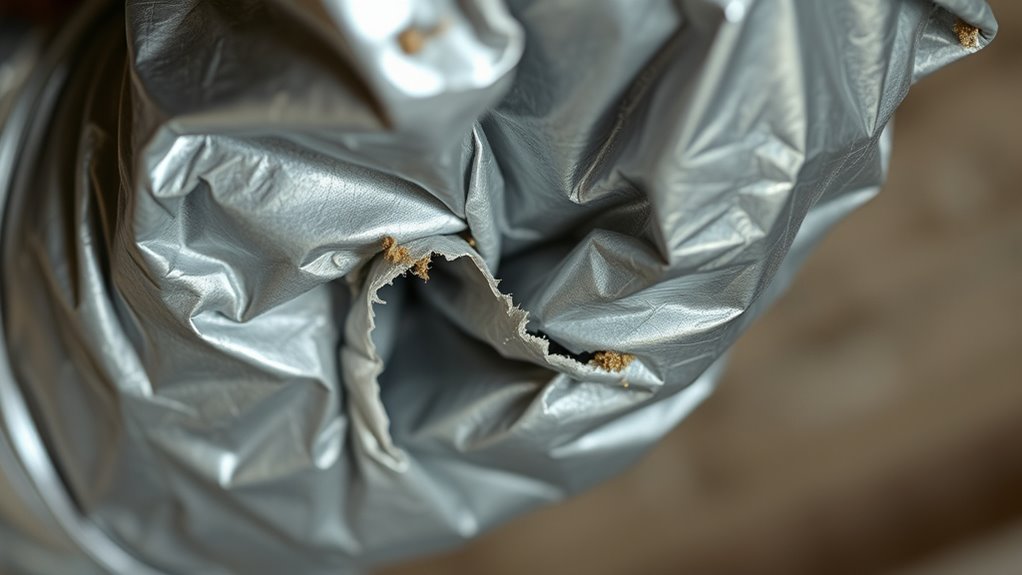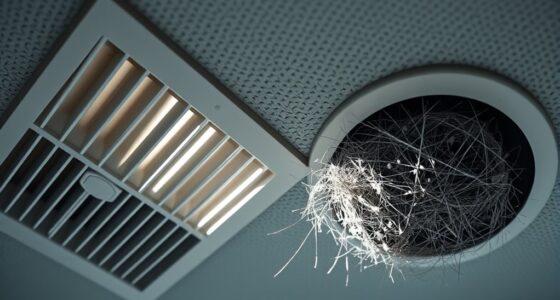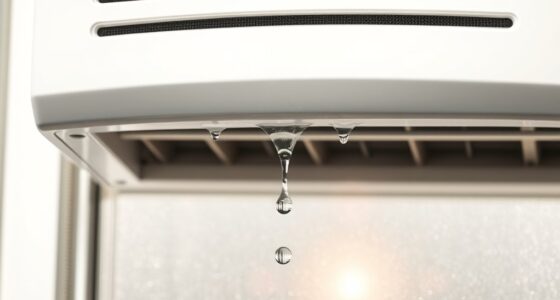Duct leaks can waste up to 30% of your cooled air, making your AC work harder and increasing your energy bills. Look for visible holes, tears, or loose connections in your ductwork, especially in less accessible areas. Sealing these leaks with professional-grade tape or sealant can dramatically improve your system’s efficiency and comfort. To fully understand how to identify and fix these hidden leaks effectively, keep exploring what you can do today.
Key Takeaways
- Duct leaks can cause up to 30% cooled air loss, reducing system efficiency and increasing energy bills.
- Signs include uneven cooling, higher utility costs, and a constantly running AC without reaching set temperature.
- Inspect ductwork regularly for visible holes, tears, or loose connections that indicate leaks.
- Use professional sealants or metal tape to properly seal identified leaks and prevent further air escape.
- Sealing duct leaks improves energy efficiency, reduces wear on the AC, and enhances indoor air quality.

Have you ever wondered why your air conditioning system isn’t cooling your home as effectively as it should? One common culprit is duct leaks, which quietly drain your system’s effectiveness. When your ducts aren’t properly sealed, cool air escapes before it reaches your living spaces, forcing your AC to work harder and longer. This not only wastes energy but also leads to higher utility bills. Duct sealing plays a crucial role in maintaining your system’s energy efficiency because it stops those leaks and ensures that cooled air stays where it’s supposed to—inside your home.
Left unaddressed, duct leaks become a silent drain on your energy resources. You might notice uneven cooling, higher energy costs, or your system running constantly without achieving the desired comfort. This is because air leaks in your ducts can amount to significant losses—sometimes up to 30% of cooled air. When that happens, your AC compensates by running longer, which accelerates wear and tear, increasing the likelihood of costly repairs down the line. Fixing these leaks is a simple yet often overlooked step that can dramatically improve your system’s performance.
Unsealed duct leaks cause up to 30% of cooled air loss, making your system work harder and increasing repair costs.
Sealing your ducts is straightforward but essential. It involves inspecting your ductwork for visible holes, tears, or loose connections and then applying specialized sealants or metal tapes designed for HVAC systems. This process should ideally be done by a professional, who can accurately identify all leaks and ensure a thorough seal. Proper duct sealing not only conserves energy but also improves indoor air quality, as less dust and contaminants escape through leaks and circulate in your home. When your ducts are sealed tight, your air conditioning system doesn’t have to work as hard to keep your space comfortable, which means lower energy bills and a more sustainable home environment.
Investing in duct sealing is a wise move if you’re looking to boost your home’s energy efficiency. It’s a cost-effective upgrade that delivers quick results—fewer leaks mean less wasted cooled air and less strain on your AC system. Plus, it can extend the lifespan of your equipment since your system won’t be overworking itself. Remember, duct leaks are often hidden behind walls or ceilings, so it’s worth having a professional conduct a thorough inspection. This way, you identify every leak and address it properly, ensuring your home stays cool without draining your wallet. Proper duct sealing can also improve your system’s air flow, which is essential for optimal performance. Ultimately, sealing your ducts is a simple step that maximizes your AC’s efficiency, saves money, and keeps your home comfortable year-round.
Frequently Asked Questions
How Can I Detect Hidden Duct Leaks Myself?
You can detect hidden duct leaks by inspecting visible duct joints for gaps or tears, then sealing them with duct tape or mastic. Use leak detection tools like a smoke pencil or a handheld infrared camera to spot escaping air. Turn on your HVAC system and feel for cold or warm air around duct connections. Regular duct sealing and these leak detection tools help identify and fix hidden leaks efficiently.
Do Duct Leaks Affect Indoor Air Quality?
Duct leaks do affect indoor air quality by introducing dust, allergens, and pollutants into your living space, reducing ventilation efficiency. When leaks occur, unfiltered air bypasses your HVAC system, spreading contaminants and decreasing air freshness. You might notice stuffiness, odors, or increased allergy symptoms. Fixing these leaks improves indoor air quality by ensuring proper ventilation, maintaining clean, healthy air, and optimizing your HVAC system’s performance for a more comfortable and safe environment.
What Are the Costs Associated With Fixing Duct Leaks?
The cost estimation for fixing duct leaks varies depending on the extent of damage, but you can expect repair expenses to range from $150 to $500. You’ll need to weigh factors like the size of your duct system and whether repairs involve sealing or replacing sections. Investing in duct sealing can improve energy efficiency and reduce long-term costs, making it a worthwhile expense for better indoor comfort and lower utility bills.
Can Duct Leaks Cause Mold Growth?
Yes, duct leaks can cause mold growth by allowing moist air to escape and increase humidity levels in your home. This excess moisture creates a perfect environment for mold to thrive. To prevent mold and maintain moisture control, it’s essential to find and seal duct leaks promptly. Proper duct sealing not only improves energy efficiency but also helps keep your indoor air quality safe and mold-free.
How Often Should Duct Inspections Be Performed?
You should inspect your ducts at least once every three to five years, even if you think they’re fine. Regular inspections catch leaks early, saving energy and improving air quality. Use duct sealant to fix minor leaks and consider insulation upgrades for better efficiency. Don’t wait until you notice higher bills or uneven cooling—proactive inspections keep your system running smoothly and prevent costly repairs down the line.
Conclusion
Don’t let sneaky leaks quietly sap your comfort and savings. By paying attention to those subtle signs and taking a proactive approach, you can seal the whispers of inefficiency before they become louder problems. Think of it as giving your AC a gentle tune-up—restoring harmony to your home’s climate. When you address these hidden holes now, you’re ensuring your system runs smoothly, quietly, and efficiently for years to come.









